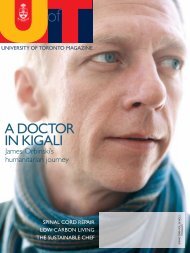What's the solution to Toronto's traffic problems? - University of ...
What's the solution to Toronto's traffic problems? - University of ...
What's the solution to Toronto's traffic problems? - University of ...
You also want an ePaper? Increase the reach of your titles
YUMPU automatically turns print PDFs into web optimized ePapers that Google loves.
Time Capsule<br />
Pr<strong>of</strong>. Vera Peters teaching<br />
at U <strong>of</strong> T in <strong>the</strong> 1960s<br />
MEDICAL PIONEER<br />
1960s<br />
Dr. Vera Peters saved<br />
lives with her treatments<br />
for breast cancer and<br />
Hodgkin’s lymphoma<br />
Open U <strong>of</strong> T’s 1934 yearbook, and you’ll find pho<strong>to</strong>s <strong>of</strong><br />
115 graduating medical students – only 10 <strong>of</strong> whom are<br />
women. Among <strong>the</strong>m is (Mildred) Vera Peters, who went<br />
on <strong>to</strong> revolutionize how Hodgkin’s lymphoma and breast<br />
cancer are treated.<br />
As a radiation oncologist at Toron<strong>to</strong> General Hospital,<br />
Dr. Peters learned that many patients wouldn’t go <strong>to</strong> <strong>the</strong><br />
doc<strong>to</strong>r if <strong>the</strong>y suspected <strong>the</strong>y had cancer. In <strong>the</strong> 1930s,<br />
being diagnosed with Hodgkin’s was like being handed a<br />
death sentence. By 1950, though, Peters and colleagues<br />
had determined that high-dose radiation could cure this<br />
lymphatic cancer if caught early. She began a lifetime<br />
crusade <strong>to</strong> encourage patients <strong>to</strong> seek prompt treatment<br />
and overcome what she coined “cancer phobia.”<br />
Women who found a breast lump were also afraid <strong>to</strong><br />
seek medical attention: <strong>the</strong> standard treatment for breast<br />
cancer was a radical mastec<strong>to</strong>my, in which <strong>the</strong> surgeon<br />
removed <strong>the</strong> entire breast. But with early-stage breast<br />
cancer, Peters excised only <strong>the</strong> tumour. In <strong>the</strong> mid-1970s,<br />
Peters, who was a pr<strong>of</strong>essor <strong>of</strong> radio<strong>the</strong>rapy and medical<br />
biophysics at U <strong>of</strong> T, published a retrospective study <strong>of</strong> <strong>the</strong><br />
8,000 breast cancer patients she had treated. It showed<br />
that treating <strong>the</strong> cancer in its early stage with a lumpec<strong>to</strong>my<br />
and radiation produced <strong>the</strong> same survival rate as a<br />
radical mastec<strong>to</strong>my.<br />
“I was refuted and shunned by most <strong>of</strong> <strong>the</strong> outstanding<br />
surgeons in <strong>the</strong> States,” Peters <strong>to</strong>ld <strong>the</strong> Oakville Medical<br />
Society in <strong>the</strong> early 1980s. She remained steadfast and<br />
as more studies found <strong>the</strong> same results, she optimistically<br />
wrote, “Mastec<strong>to</strong>my in early breast cancer may become<br />
as old-fashioned as bloodletting.”<br />
– SUSAN PEDWELL<br />
52 www.magazine.u<strong>to</strong>ron<strong>to</strong>.ca<br />
PHOTO: U OF T ARCHIVES B1996-0019/001(07)

















